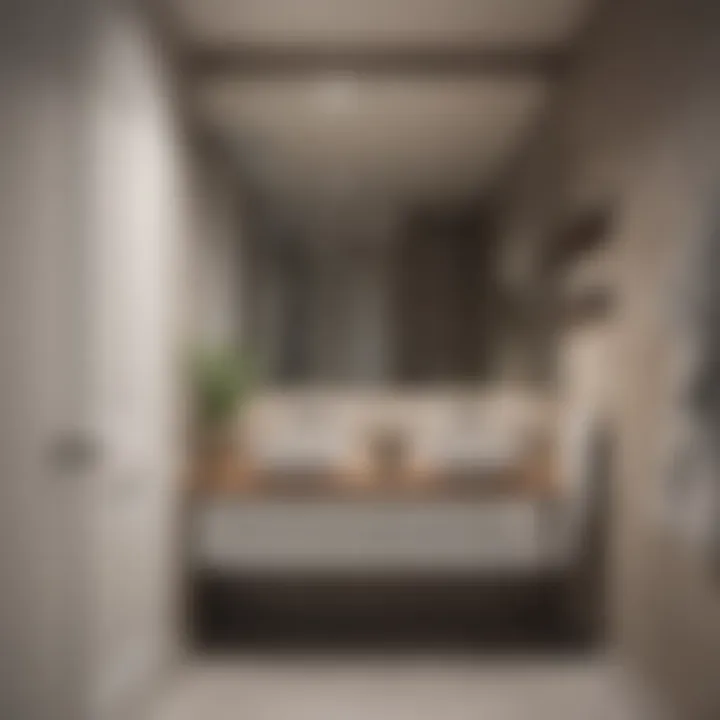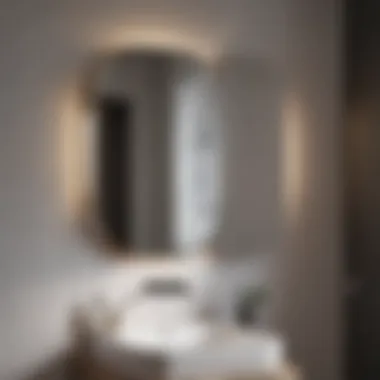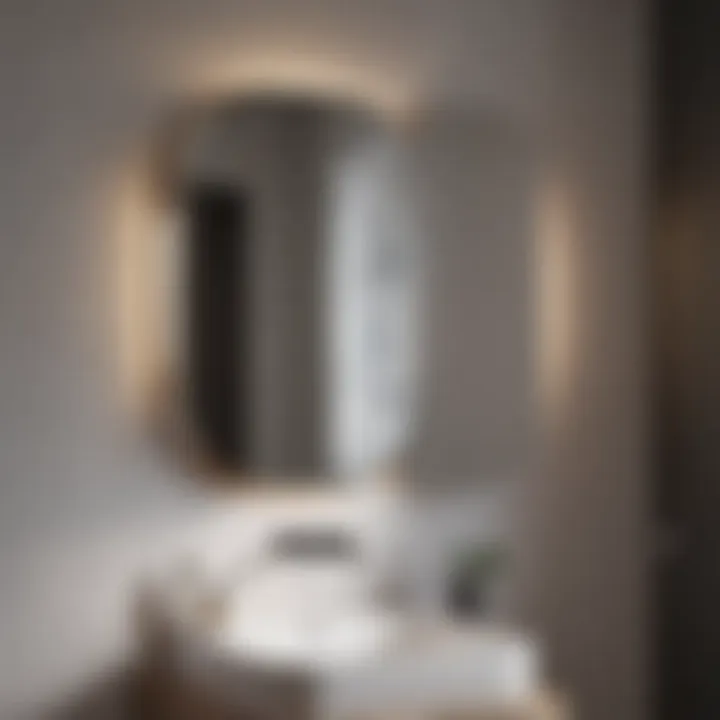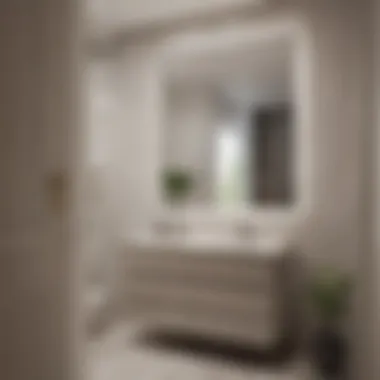Enhancing Bathrooms: Mirrors on Door Back for Style


Intro
The integration of mirrors into the home goes beyond basic functionality. Particularly, mirrors placed on the back of bathroom doors serve a dual purpose — they are both practical and aesthetically appealing. This article explores the diverse roles mirrors play in bathrooms, focusing on their usefulness in small spaces as well as their impact on interior design.
Homeowners and design enthusiasts will find valuable insights into selecting, installing, and maintaining these reflective pieces. With the right mirror, bathrooms can transform from ordinary to extraordinary, contributing to a sense of space and style.
Design Inspirations
Mirrors on the back of bathroom doors can enhance any bathroom's visual appeal. They can reflect light, making the space seem larger than it is. Homeowners should consider various design elements when incorporating mirrors.
Trending Styles
In recent years, minimalist designs have gained traction. Mirrors that feature clean lines and are frameless create an illusion of space while maintaining simplicity. Alternatively, vintage-style mirrors with ornate frames can provide a touch of elegance. One can also explore geometric designs that lend a modern flair.
Color Palettes
For color, sticking to neutral tones can offer versatility that complements any decor. However, bold colors in mirror frames can serve as eye-catching statements. Homeowners should select colors that match the overall bathroom theme. This coherence will enhance the aesthetics, creating a harmonious environment.
Maintenance and Upkeep
Maintaining mirrors on bathroom doors is essential for their longevity and functionality. Regular care not only preserves their appearance but also ensures optimal performance.
Seasonal Maintenance Checklist
- Inspect for Damage: Check the mirror for any cracks or chips.
- Tighten Fixtures: Ensure that any mounting hardware is secure.
- Clean the Surface: Use appropriate cleaner to remove streaks and water spots.
Cleaning and Organization Tips
- Use a microfiber cloth: This prevents scratches when cleaning.
- Avoid abrasive substances: Harsh chemicals can damage the reflective surface.
- Store cleaning supplies nearby: Keep tools handy for easy access to maintenance.
Regular maintenance can save homeowners from expensive replacements down the line.
Prolusion to Bathroom Mirrors
Mirrors in bathrooms serve many purposes. They are more than just reflective surfaces; they influence interior design and usability. In this article, we will delve into the various roles that mirrors play in bathroom spaces, particularly focusing on their placement on the back of bathroom doors. The combination of aesthetics and practicality is essential for maximizing functionality in often limited spaces.
The importance of mirrors lies not only in their role for grooming and personal care but also in their ability to alter perceptions of space. A well-placed mirror can create an illusion of depth, making smaller bathrooms appear more expansive. This is particularly valuable for homeowners aiming to enhance the overall ambience of their bathrooms.
The Role of Mirrors in Interior Design
Mirrors act as design elements, adding elegance and sophistication. When placed strategically, they can reflect light and enhance the color palette of a room. This plays a major role in interior design by harmonizing various elements within the space. The right mirror can complement existing decor, serving as a focal point or blending seamlessly with surrounding features.
Incorporating mirrors into bathroom design opens up numerous possibilities. There is a wide range of styles, from minimalist designs to ornate framings, allowing customization based on individual tastes and preferences. Moreover, the reflective quality of mirrors can contribute to a brighter atmosphere in bathrooms, particularly those without windows.
Historical Use of Mirrors in Bathrooms
The use of mirrors in bathrooms has evolved over centuries. In past centuries, bathrooms were primarily functional spaces. However, as societal norms around personal grooming changed, so too did the architecture of these spaces. Early designs featured small, basic mirrors, which served only practical purposes.
As interior design developed, mirrors became integral in creating luxurious environments. From the grand marble bathrooms of the Victorian era adorned with large, opulent mirrors to the modern minimalist approaches, the importance of mirrors has grown.
Today, the back of bathroom doors is a practical place for mirrors, allowing users to check their appearance without occupying valuable wall space. This development reflects a blend of functionality and modern design sensibilities. Mirrors not only fulfill practical needs but also contribute to the overall aesthetic of a bathroom, making them indispensable in contemporary home design.
Benefits of Installing Mirrors on Bathroom Doors
The inclusion of mirrors on the back of bathroom doors provides varying advantages that enhance both the functionality and the aesthetics of this often-overlooked space. As bathrooms can frequently feel enclosed or dim, adding mirrors considerably transforms the experience of using these areas. In this section, we will explore three significant benefits of bathroom door mirrors: maximizing space, enhancing natural light, and offering practical uses for daily routines.


Maximizing Space in Small Bathrooms
Installing mirrors on bathroom doors is especially valuable in small bathrooms. When floor space is limited, mirrors can create an illusion of depth, making the room feel larger than it actually is. Reflective surfaces generate a sense of openness and alleviation from the cramped quarters native to many smaller layouts. During design considerations, it is essential to choose mirrors that not only fit the space available but also reflect the decor in those areas, reinforcing the overall aesthetics rather than cluttering the environment.
Furthermore, strategically placing mirrors where natural light can be reflected doubles the effect of room brightness and space. It is fundamental to ensure that the mirror will catch light from windows or skylights. Using a mirror on the bathroom door effectively suits both practical and visual needs in confined spaces.
Enhancing Natural Light
Natural light plays an essential role in all interior spaces, particularly in bathrooms where illumination may be scarce. Mirrors on the back of bathroom doors can significantly contribute to this aspect. By reflecting light coming from windows and other sources, mirrors effectively amplify brightness throughout the room. This enhancement not just elevates the atmosphere, but also can create a more inviting and uplifting environment.
Moreover, utilizing mirrors in a clever way can reduce the reliance on artificial lighting during the day. This energy-efficient approach is both beneficial for the environment and reduces overall electricity costs. Homeowners pay particular attention to the positioning of mirrors to ensure optimal reflection capabilities. A well-placed mirror can transform an ordinary bathroom into a more airy and vibrant space.
Practical Uses and Daily Functionality
Mirrors serve more than merely aesthetic purposes; they also fulfill practical roles within our daily routines. Having a mirror on the back of the bathroom door allows individuals to check their appearance quickly before leaving the house. It provides a space for last-minute grooming activities, from adjusting hair to applying makeup.
Additionally, mirrors can assist in evaluating lighting conditions and ensure that the colors worn align with what might be viewed outside. Incorporating organized shelving or hooks nearby can further enhance the functionality of the space, ensuring that users have everything they need at hand.
In summary, mirrors on bathroom doors prove highly effective in transforming the user experience within a bathroom. From creating illusions of space to enhancing natural light and providing practical daily functionality, these mirrors play a vital role for homeowners and design enthusiasts alike. Their capacity to merge beauty with utility is a compelling reason to consider this aspect of bathroom design.
Types of Mirrors Available for Bathroom Doors
Understanding the various types of mirrors available for bathroom doors is essential for anyone looking to enhance their space. The right mirror can significantly impact the functionality and aesthetic appeal of a bathroom. When selecting mirrors, one should consider factors such as size, style, and the specific needs of the space. This section will delve into the primary categories of mirrors suited for bathroom doors, providing insights into the practical and decorative aspects of each type.
Framed vs. Frameless Mirrors
Framed mirrors bring a sense of completeness to a bathroom. The frame itself can be a design statement, offering various materials, colors, and styles to choose from. A wooden frame adds warmth, whereas a sleek metal frame delivers a modern touch. Framed mirrors also tend to feel more robust and are often easier to handle during installation. They can complement existing decor and provide a finished look.
On the other hand, frameless mirrors offer a minimalist design. Their clean lines and seamless look create an illusion of space, making them an excellent choice for small bathrooms. Frameless mirrors can be mounted flush against the wall or the door, producing a sophisticated, unencumbered appearance. Furthermore, they are often easier to clean since there are no frames to obstruct the glass. Homeowners should consider factors like personal preference and existing bathroom style when choosing between the two.
Sliding and Bi-fold Mirrors
Sliding mirrors are a clever solution for maximizing space. They allow easy access while saving room compared to traditional hinged doors. These mirrors slide to the side, perfect for smaller bathrooms where every inch counts. A sliding mirror can also act as a secondary function, serving as a partition if designed thoughtfully.
Bi-fold mirrors can be another space-saving solution. They expand outwards and fold back, allowing flexible access. They are useful when one needs a larger reflection surface. Also, bi-fold mirrors can give the illusion of a larger space, particularly in narrow settings. Choosing between sliding and bi-fold options depends on the amount of space available and the desired look.
Custom and DIY Mirror Options
Custom mirrors offer the chance to create a truly unique look. They can be tailored to fit specific measurements and aesthetic preferences. Perhaps a homeowner prefers a particular shape or style that standard mirrors do not offer. Working with a designer can yield results that reflect one’s personality and complement bathroom decor.
For those who enjoy hands-on projects, DIY mirrors can be an engaging option. This may involve purchasing a basic mirror and enhancing it with personal touches such as paint or decorative trim. DIY can also include creative mounting solutions like hooks or shelves. This not only lowers costs but also results in a mirror that fits perfectly in the intended space while showcasing individual creativity.
Aesthetic Considerations for Mirror Design
When selecting mirrors for the back of bathroom doors, aesthetic considerations play a crucial role. The design of a mirror can significantly alter the visual appeal of a bathroom, making it essential to choose wisely. Mirrors not only serve functional purposes but also act as key design elements. They can enhance the overall atmosphere of the space, making it feel harmonious and cohesive. Selecting a mirror that aligns with the existing design elements provides a polished look that reflects the homeowner’s personal style.
Choosing the Right Style to Complement Your Space
The style of a mirror should complement the overall decor of the bathroom. For example, if the bathroom embraces a modern aesthetic, opting for sleek, frameless designs may be the best choice. Conversely, for a more traditional setting, framed mirrors with ornate detailing can add character and charm.
- Considerations for style selection:
- Analyze existing fixtures and fittings like taps and cabinets.
- Determine whether you prefer minimalist or intricate designs.
- Assess the overall size of the bathroom to avoid overwhelming the space with oversized mirrors.
It is also important to consider the shape of the mirror. Round mirrors can soften the visuals in a space dominated by angular lines while rectangular mirrors tend to offer a more streamlined appearance. The right style contributes to a balanced look that enhances the usability of the bathroom.
Color and Finish Options


The color and finish of a mirror affect its integration into the bathroom’s design scheme. Mirrors can have a variety of finishes, including chrome, brushed nickel, and matte black. These finishes not only contribute to the durability of the mirror but also tie in with other bathroom elements, such as lighting fixtures and hardware.
- Key factors in choosing colors and finishes:
- Ensure the color matches or harmonizes with other bathroom fixtures.
- Consider the lighting, which can influence how color appears during day and night.
- Select finishes that are resistant to humidity and water damage for long-lasting performance.
A well-chosen color and finish can elevate the bathroom’s design, creating a thoughtful and cohesive environment.
Integrating Mirrors with Bathroom Themes
Mirrors can be powerful tools for reinforcing the theme of a bathroom. Whether it's a coastal, rustic, or luxurious aesthetic, mirrors can help communicate this style. For instance, a mirror with a driftwood frame is perfect for a beach-themed bathroom, while a sleek, glossy mirror can enhance a modern luxury appeal.
- Ways to integrate mirrors with themes:
- Match mirror frames with different types of wood or metal accents used in the bathroom.
- Use decorative elements that reflect the theme, such as shells for a coastal vibe or vintage frames for a retro look.
- Keep the mirror’s design in sync with flooring and wall colors for a seamless appearance.
The integration of mirrors within the thematic design enriches the user’s experience, making the space more inviting and unique.
Installation Tips for Back-of-Door Mirrors
Installing mirrors on the back of bathroom doors requires careful planning and execution. This section addresses practical tips that can ensure a successful installation. The right installation can enhance both functionality and aesthetics, making this a crucial part of deploying mirrors in bathrooms. Proper measurement, secure mounting, and addressing door material are three essential considerations.
Measuring and Positioning the Mirror
Accurate measurement is critical when installing a mirror on the back of a bathroom door. Begin by determining the ideal height at which to place the mirror. Typically, the center of the mirror should align with the eye level of the tallest user in the household. This practice ensures maximum usability.
Use a tape measure to gauge the door's dimensions, accounting for any fixtures or hardware on the door that may interfere with the mirror. Mark the desired position with a pencil. It is advisable to measure twice and mark once to avoid unnecessary holes and adjustments.
Secure Mounting Techniques
Secure mounting is paramount for safety and longevity. Various mounting options are available, such as adhesive strips or brackets. If using brackets, choose those that can support the weight of the mirror.
- Adhesive Strips: These can be effective but ensure they are rated for the weight of the mirror.
- Wall Hooks: If opting for wall hooks, position them in a way that distributes the mirror's weight evenly.
- Brackets: For heavier mirrors, brackets offer a more stable solution. Drill screws directly into the door for a firm hold.
Test the stability of the installation by applying light pressure to ensure it does not shift.
Addressing Door Thickness and Material
Understanding the door's thickness and material is vital for a successful mirror installation. Different materials may require specific fasteners or installation techniques.
- Wooden Doors: Standard screws or adhesive hooks work well on wooden doors. Ensure screws are not over-tightened to avoid damaging the wood.
- Hollow Core Doors: Use toggle bolts or anchors for added support, as these doors lack the solid backing found in solid doors.
- Metal Doors: Magnetic strips or specialized brackets are advisable.
Make sure to adjust mounting techniques based on the door's characteristics to prevent any mishaps.
Maintenance and Cleaning of Bathroom Door Mirrors
Maintaining and cleaning bathroom door mirrors is essential not only for visual appeal but also for functionality. Regular upkeep can enhance the lifespan of the mirror and ensure a clear reflection. This can be quite significant in the context of small bathrooms or spaces where maximizing visibility is critical. Keeping mirrors clean reduces streaks and smudges, allowing for a more pleasant experience during daily routines such as grooming and applying makeup. Furthermore, it contributes to overall hygiene in the bathroom environment.
Choosing Appropriate Cleaning Products
When selecting cleaning products for bathroom mirrors, it is crucial to choose ones that do not contain harsh chemicals or abrasive materials. These can scratch or damage the surface of the mirror. Instead, opt for gentle glass cleaners or a simple mixture of vinegar and water. This natural solution can effectively cut through grime and leave a streak-free shine.
Some recommended products include:
- Windex: A popular glass cleaner that is effective and easy to use.
- Simple Green: An environmentally friendly cleaner that works on multiple surfaces.
- Homemade Vinegar Mixture: A solution using equal parts of distilled vinegar and water.


Tools for cleaning, such as microfiber cloths, should also be considered. They are soft and effective at absorbing moisture without leaving lint behind.
Regular Maintenance Practices
Establishing a routine for mirror maintenance can greatly enhance clarity and appearance. Here are some practices that homeowners should follow:
- Weekly Cleaning: Set aside some time each week to wipe the mirror. Use a suitable cleaning product and a microfiber cloth for best results.
- Monthly Deep Clean: Every month, take extra time to clean around the edges and behind the mirror, if accessible. This can prevent dust buildup and enhance overall cleanliness.
- Immediate Spot Clean: Address any spills or stains immediately to prevent them from becoming permanent marks.
- Check for Damage: Regularly inspect the mirror for any chips or cracks. If found, look into replacing it to maintain safety.
Adhering to these cleaning practices not only preserves the aesthetic quality of mirrors on bathroom doors but also promotes a healthier living space.
The Psychology of Mirrors in Personal Spaces
Mirrors are more than mere reflections; they are tools that influence how we perceive ourselves and how we navigate our day-to-day lives. Understanding the psychology behind mirrors, especially in personal spaces like bathrooms, can provide valuable insights into their role in both functional and emotional contexts.
Self-Perception and Body Image Considerations
When we look into a mirror, we see not only our physical form but also how we feel about ourselves. A well-placed mirror at the back of a bathroom door offers convenience during daily routines. However, it also serves as a potent reminder of body image constructs. Research suggests that frequent exposure to one’s reflection can impact self-esteem and self-worth. For homeowners and design enthusiasts, it is essential to consider the dimensions and positioning of these mirrors. A larger mirror can create a sense of openness and enhance body positivity, while a small or poorly positioned mirror might evoke negative feelings or scrutiny.
Furthermore, the design choice—whether framed, frameless, or embellished—can also affect mood. A sleek, minimalist mirror may inspire a sense of calm, whereas a more ornate design could provoke feelings of grandeur or nostalgia.
"The simplest way to improve self-perception is to strategically use mirrors as a functional yet aesthetic element in personal spaces."
Facilitating Daily Routines
The placement of mirrors in personal spaces, particularly in bathrooms, plays a crucial role in streamlining daily tasks. Consider the habitual routines that take place every morning, from brushing teeth to applying makeup. Having a mirror on the back of the door creates seamless visibility without the need to step into a cramped area or navigate around obstacles. This arrangement allows for greater freedom of movement and encourages efficiency.
Moreover, mirrors can enhance focus. When an individual sees their reflection while engaging in grooming tasks, it can reinforce a sense of purpose. This visual feedback loop can assist in maintaining attentiveness. Furthermore, the act of grooming itself is often associated with self-care, promoting mental and emotional well-being.
In terms of design, the mirror should reflect not just the individual's image but also the aesthetics of the entire bathroom. A well-coordinated mirror can contribute to an inviting atmosphere, making the process of getting ready more enjoyable. Utilizing mirrors effectively supports both the emotional and practical sides of daily routines.
Safety Concerns and Recommendations
When considering the practicality of installing mirrors on the back of bathroom doors, safety concerns should not be overlooked. Mirrors, while functional and aesthetically pleasing, pose certain risks if not selected or installed properly. Understanding these concerns can guide homeowners in making informed decisions that protect both individuals and the overall integrity of the bathroom environment.
Using Shatterproof Glass
The use of shatterproof glass is one significant safety consideration. Standard mirrors can easily break, leading to sharp shards that can cause serious injury. Shatterproof glass, or safety glass, is designed to minimize the risk of dangerous accidents. It does not shatter into sharp pieces but rather tends to crack in a less hazardous manner due to its laminated construction. This type of glass can be particularly beneficial in homes with children or in areas prone to slipping, like bathrooms.
Additionally, shatterproof mirrors often come with a protective film that keeps the glass intact even when broken, preventing shards from scattering. An investment in such materials may add to the initial cost, but the safety benefits far outweigh these expenses. Homeowners can seek mirrors made of polycarbonate or treated acrylic, as these materials are not only lighter but also provide a reliable alternative to traditional glass.
Securing Edges to Prevent Injuries
Securing the edges of mirrors is another critical aspect to ensure safety. Sharp or unsealed edges can result in cuts or scrapes during routine activities such as closing doors or brushing past. To address this, many manufacturers offer mirrors with rounded or beveled edges for added safety. If a standard mirror is purchased, consider applying edge banding or tape as a quick remedy. These solutions give an additional layer of security, particularly for mirrors installed on vulnerable surfaces like doors, which can be frequently bumped into.
Moreover, using proper mounting hardware that supports the mirror's weight eliminates the risk of falling. Adhesive strips or hooks may not be sufficient for heavier mirrors. It is advisable to use wall anchors or screws designed specifically for bathroom settings to ensure stability. Taking these safety measures will not only protect individuals but also enhance the durability of the installation.
"Safety measures should always align with aesthetics in bathroom design, promoting a space that is as safe as it is stylish."
In summary, addressing safety concerns regarding mirrors on bathroom doors involves selecting appropriate materials and ensuring that installation is secure. By prioritizing shatterproof options and proper edge treatment, homeowners can create a safe environment while integrating functional design into their bathrooms.
The End
Mirrors on the back of bathroom doors serve not just a functional purpose but also enhance the overall aesthetics of the space. They provide a unique blend of practicality and design flair. When considering mirrors for bathroom doors, it is essential to reflect on various elements such as size, style, and installation method.
Reflecting on the Importance of Consideration
When choosing a mirror, thoughtful consideration impacts the effectiveness of space utilization. A well-placed mirror can create the illusion of a larger area, offering a more spacious feeling in compact bathrooms. It can also balance light sources and improve natural lighting. Homeowners should evaluate the importance of selecting a style that aligns with existing decor. This harmonizes the bathroom's visual appeal while maintaining functionality in daily routines.
In addition to style, the practical aspects of installation must not be overlooked. The correct mounting ensures durability and safety. Shatterproof glass technology addresses safety concerns, especially in homes with children.
Final Thoughts on Bathroom Door Mirrors
When investing in such features, it pays to focus on quality and style. A carefully chosen mirror can effortlessly transition between different interior design themes, ensuring compatibility over time. Thus, mirrors serve as valuable assets in the quest for an optimized bathroom environment.







